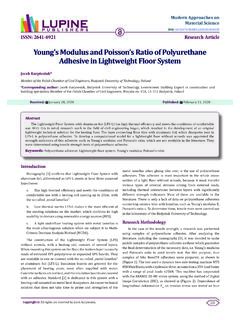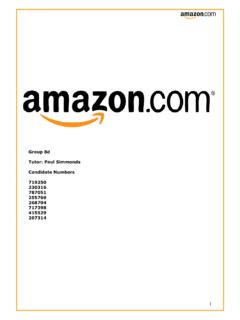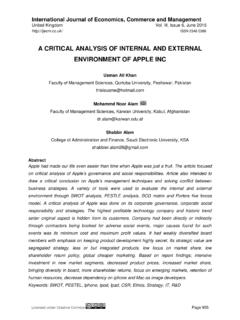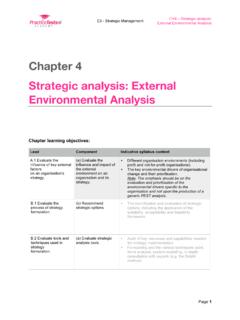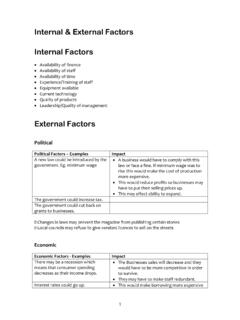Transcription of Analysis of Fashion Industry Business Environment
1 Citation: R B Chavan. Analysis of Fashion Industry Business Environment . Trends in Textile & Fash Design 2(4)-2018. DOI: UPINE PUBLISHERS Open AccessLLatest Trends in Textile and Fashion DesigningReview ArticleAnalysis of Fashion Industry Business EnvironmentR B Chavan*Institute of Appropriate and Sustainable Technology, Maharashtra, IndiaReceived: August 01, 2018; Published: August 09, 2018*Corresponding author: R B Chavan, Institute of Appropriate and Sustainable Technology, Aurangabad Maharashtra, IndiaIntrodutionPrior to the mid-19th century, most clothing was custom-made. It was handmade for individuals, either as home production or on order from dressmakers and tailors. By the beginning of the 20th century-with the rise of new technologies such as the sewing machine, the rise of global capitalism and the development of the factory system of production, and the proliferation of retail outlets such as department stores-clothing had increasingly come to be mass-produced in standard sizes ready for sale.
2 Although the Fashion Industry developed first in Europe and America, presently it is an international and highly globalized Industry , with clothing often designed in one country, manufactured in another, and sold worldwide. For example, an American Fashion company might source fabric in China and have the clothes manufactured in Vietnam, finished in Italy, and shipped to a warehouse in the United States for distribution to retail outlets internationally. The Fashion Industry has long been one of the largest employers. However, due to increase in labor costs it has moved from developed countries to developing particularly China and African countries [1]. Fashion Industry employs people across occupation from skilled labour to Fashion designers, computer programmers, lawyers, accountants, copywriters, social media directors, and project managers. Manufacturing is only a fraction of the modern Fashion Industry as it is a highly sophisticated Industry involving Fashion and market research, brand licensing/intellectual property rights, design, materials engineering, product manufacturing, marketing and finally, distribution [2].
3 Components of Fashion industryThe Fashion Industry consists of four components/levels:a) The production of raw materials, principally fibers, textiles, leather and ) The production of Fashion goods by designers, manufacturers, contractors, and ) Marketing in the form of advertising and ) Wholesale/Retail sales and e- levels consist of many separate but interdependent sectors. These sectors are Textile Design and Production, Fashion Design and Manufacturing, Fashion Retailing, Marketing AbstractThe notion of global Fashion Industry is a product of the modern age as clothing is often designed in one country, manufactured in another, and sold worldwide. The global Fashion Industry is dependent on ever-changing trends that keep consumers, driven by the need to wear the latest. The paper highlights the fast Fashion and slow Fashion models prevailing in the Fashion Industry . Among the two models the fast Fashion model is well established, however the slow Fashion model is gaining importance as it discourages undesirable excessive use of clothing resulting in the waste recycling problems and threat to Environment .
4 The paper also peeps through the internal, micro and macro factors influencing the Business Environment of Fashion Industry and ways and means to overcome these factors to meet the ultimate goal to establish successful relationship with customers with reasonable profit. The macro factors are often referred as pestel (political, economic, technology, Environment and legal) factors. It has been pointed out that among these pestel factors, presently the environmental factors and social factors of Business ethics are posing a serious threat to the sustainability of fast Fashion model of the Fashion : Fashion Industry ; Business Environment ; Internal, micro and macro; pestel ; Fast Fashion ; Slow fashionISSN: 2637-4595 DOI: in Textile & Fash DesignCopyrights@ R B : R B Chavan. Analysis of Fashion Industry Business Environment . Trends in Textile & Fash Design 2(4)-2018. DOI: Merchandising, Fashion Shows, and Media and Marketing. Each sector is devoted to the goal of satisfying consumer demand that enable designers, manufacturers, retailers and marketing firms to operate for a profit [1].
5 Global Fashion industryThe global Fashion Industry is dependent on ever-changing trends that keep consumers, driven by the need to wear the latest. However, this means that goods have a short shelf life, requiring manufacturers, designers and retailers to meet tight production schedules and distribution deadlines. This also gives trendsetters, such as celebrities, key roles in successful marketing and promotions. In a global marketplace, the Fashion Industry is highly competitive. Though manufacturing is carried out in developing countries of Asia and Africa due to cheap labor, China is claiming a majority stake by offering quality goods at cheaper prices. The Fashion Industry is no longer solely dependent on retail stores for sales due increase in opportunities for retail sales through e-commerce, which allows buyers to shop and purchase online. Marketing and promotion also are expanding with the growth of such media trends as social networking and use of technologies such as mobile devices and smart phone applications, which allow for shopping anywhere.
6 Product branding is an important part of gaining recognition and customer loyalty. This segment of the market, promoted by designers and Fashion models, is among the most visible. It also presents greater challenges for lesser known product lines [3]. Business models of Fashion industryThe Fashion Industry is a dynamic in the sense that Fashion trends and styles change continuously. Each Fashion company responds differently to the changes in Fashion trends, distribution and selling of clothes to its customers. The majority of companies choose to follow the latest Fashion trends while new entrants try to emphasize quality over quantity by striving for a more sustainable and long- lasting approach. These differences are generally illustrated by two Business models, which have emerged over the past few years within the Fashion Industry , namely the fast Fashion and slow Fashion model. According to Fletcher fast Fashion is time based whereas slow Fashion is rather quality-based [4].
7 Fast Fashion modelCompanies following the fast Fashion Business model are characterized by a quick response to the latest Fashion trends as well as short production and lead times resulting in quick supply to market and customers [5]. New designs and collections are introduced within weeks, which keep customers continuously dropping by the stores in order to review the latest Fashion styles [6]. Adopters of the fast Fashion model are concerned with bringing new products very quickly to the market in order to capture and directly respond to the latest trends in the market [7]. Fast Fashion model is characterized by low prices, a short time-to-market and reduced lead times resulting in a delivery of new clothes to customers several times within a season. In comparison to slow Fashion concept, the fast Fashion concept is well-established in apparel market and numerous renowned Fashion companies like Zara, H&M, Top Fashion , GAP have successfully implemented the approach in their Business strategies [8,9].
8 Slow Fashion modelCompared to the fast Fashion model, slow Fashion is more novel. It is concerned with creating a more sustainable and ethical supply chain highlighting the use of local resources and longer product lives [10]. In contrast to fast Fashion , slow Fashion promotes a more conscious buying behavior and motivates customers to be more aware of the materials used to create their looks. It tries to incorporate green thinking into the Fashion world and pulls customers away from the throw-away culture that has been created with the emergence of the fast Fashion concept. Slow Fashion rather stands for attributes like sustainability and quality and an effort to decrease over-consumption and encourage a more conscious approach to purchasing clothes [11-14]. Slow Fashion model goes beyond sustainability where companies also engage in a transparent supply chain management and incorporate ethical and socially responsible initiatives while not losing sight of creativity and fashionability of their products.
9 The prominence of the slow Fashion Business model is recently increasing, and more and more entrepreneurs establish new and prospering businesses under this concept [10]. Due to this upheaval, the slow Fashion concept will be considered as new entrant since it is only in the early stages of market 1 provides a more detailed overview of the two Business 1: Overview of fast Fashion and slow Fashion models [13]. Fast FashionSlow FashionDefinitionFast Fashion describes the retail strategy of adapting merchandise assortments to Current and emerging trends as quickly Effectively as possible. It is a different approach in which designers, buyers, retailers and consumers are more aware of the impact of product on workers, communities and eco-system.
10 It is about a richer interaction between designer and maker, maker and garment and garment and 1980 s2007 FocusTime basedQuality basedTrends in Textile & Fash DesignCitation: R B Chavan. Analysis of Fashion Industry Business Environment . Trends in Textile & Fash Design 2(4)-2018. DOI: Copyrights@ R B modelsOpportunity pull modelDesigner push modelFeaturesHighly responsive supply chain, speed to market, sensitivity to trends. New merchandise every week. over quantity, responsibility, sustainability, transparency, eco-friendly, ethical, Trans-seasonal and materialsOut sourcing, external suppliers, manufacturing in low cost countries, Synthetic fabric like polyester, nylon, non-organic cotton, production, Fair trade, Recycling, High quality organic fabric like cotton, wool, silk, hemp, price is cheaper Original price is more expensiveCriticismEnvironmental pollution, Inhumane labor standards, Unconscious shopping, Waste, McFashion , Creation of culture of disposable prices, Questionable trendiness of product, Limited availability of eco-friendly , H&M, Top Fashion , Forever-21, by, Pantagonia, Adili, CIEL, Must of fast Fashion and slow Fashion modelsBusiness environmentBusiness Environment is a marketing term and refers to factors and forces that affect a firm s ability to build and maintain successful relationships with current and prospective customers.

